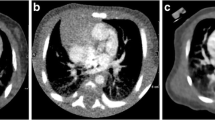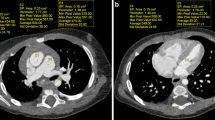Abstract
Background
Image sharpness is commonly degraded on cardiac CT images reconstructed using iterative reconstruction algorithms.
Objective
To compare the image quality of cardiac CT between raw-data-based and model-based iterative reconstruction algorithms developed by the same CT vendor in children and young adults with congenital heart disease.
Materials and methods
In 29 patients with congenital heart disease, we reconstructed 39 cardiac CT datasets using raw-data-based and model-based iterative reconstruction algorithms. We performed quantitative analysis of image sharpness using distance25–75% and angle25–75% on a line density profile across an edge of the descending thoracic aorta in addition to CT attenuation, image noise, signal-to-noise ratio and contrast-to-noise ratio. We compared these quantitative image-quality measures between the two algorithms.
Results
CT attenuation did not show significant differences between the algorithms (P>0.05) except in the aorta. Image noise was small but significantly higher in the model-based algorithm than in the raw-data-based algorithm (4.8±2.3 Hounsfield units [HU] vs. 4.7±2.1 HU, P<0.014). Signal-to-noise ratio (110.2±50.9 vs. 108.4±50.4, P=0.050) and contrast-to-noise ratio (91.0±45.7 vs. 89.6±45.1, P=0.063) showed marginal significance between the two algorithms. The model-based algorithm showed a significantly smaller distance25–75% (1.4±0.4 mm vs. 1.6±0.3 mm, P<0.001) and a significantly higher angle25–75% (77.0±4.3° vs. 74.1±5.7°, P<0.001) than the raw-data-based algorithm.
Conclusion
Compared with the raw-data-based algorithm, the model-based iterative reconstruction algorithm demonstrated better image sharpness and higher image noise on cardiac CT in patients with congenital heart disease.



Similar content being viewed by others
References
Goo HW, Park IS, Ko JK et al (2003) CT of congenital heart disease: normal anatomy and typical pathologic conditions. Radiographics 23:S147–S165
Goo HW, Park IS, Ko JK et al (2005) Computed tomography for the diagnosis of congenital heart disease in pediatric and adult patients. Int J Cardiovasc Imaging 21:347–365
Lee T, Tsai IC, Fu YC et al (2006) Using multidetector-row CT in neonates with complex congenital heart disease to replace diagnostic cardiac catheterization for anatomical investigation: initial experiences in technical and clinical feasibility. Pediatr Radiol 36:1273–1282
Goo HW (2010) State-of-the-art CT imaging techniques for congenital heart disease. Korean J Radiol 11:4–18
Han BK, Lesser AM, Vezmar M et al (2013) Cardiovascular imaging trends in congenital heart disease: a single center experience. J Cardiovasc Comput Tomogr 7:361–366
Goo HW (2013) Current trends in cardiac CT in children. Acta Radiol 54:1055–1062
Yang JC, Lin MT, Jaw FS et al (2015) Trends in the utilization of computed tomography and cardiac catheterization among children with congenital heart disease. J Formos Med Assoc 114:1061–1068
Kalra MK, Maher MM, Toth TL et al (2004) Strategies for CT radiation dose optimization. Radiology 230:619–628
McCollough CH, Bruesewitz MR, Kofler JM Jr (2006) CT dose reduction and dose management tools: overview of available options. Radiographics 26:503–512
Goo HW (2012) CT radiation dose optimization and estimation: an update for radiologists. Korean J Radiol 13:1–11
Lee ES, Goo HW, Lee JY (2015) Age- and gender-specific estimates of cumulative CT dose over 5 years using real radiation dose tracking data in children. Pediatr Radiol 45:1282–1292
Hui PKT, Goo HW, Du J et al (2017) Asian consortium on radiation dose of pediatric cardiac CT (ASCI-REDCARD). Pediatr Radiol 47:899–910
Hong SW, Goo HW, Maeda E et al (2019) User-friendly vendor-specific guideline for pediatric cardiothoracic computed tomography provided by the Asian Society of Cardiovascular Imaging Congenital Heart Disease Study Group: Part 1. Imaging techniques. Korean J Radiol 20:190–204
Leipsic J, Heilbron BG, Hague C (2012) Iterative reconstruction for coronary CT angiography: finding its way. Int J Cardiovasc Imaging 28:613–620
Tricarico F, Hlavacek AM, Schoepf UJ et al (2013) Cardiovascular CT angiography in neonates and children: image quality and potential for radiation dose reduction with iterative image reconstruction techniques. Eur Radiol 23:1306–1315
Winklehner A, Karlo C, Puippe G et al (2011) Raw data-based iterative reconstruction in body CTA: evaluation of radiation dose saving potential. Eur Radiol 21:2521–2526
Moscariello A, Takx RA, Schoepf UJ et al (2011) Coronary CT angiography: image quality, diagnostic accuracy, and potential for radiation dose reduction using a novel iterative image reconstruction technique — comparison with traditional filtered back projection. Eur Radiol 21:2130–2138
Han BK, Grant KI, Garbrich R et al (2012) Assessment of an iterative reconstruction algorithm (SAFIRE) on image quality in pediatric cardiac CT datasets. J Cardiovasc Comput Tomogr 6:200–204
Nie P, Li H, Duan Y et al (2014) Impact of sinogram affirmed iterative reconstruction (SAFIRE) algorithm on image quality with 70 kVp-tube-voltage dual-source CT angiography in children with congenital heart disease. PLoS One 9:e91123
Patino M, Fuentes JM, Hayano K et al (2015) A quantitative comparison of noise reduction across five commercial (hybrid and model-based) iterative reconstruction techniques: an anthropomorphic phantom study. AJR Am J Roentgenol 204:W176–W183
Millon D, Vlassenbroek A, Van Maanen AG et al (2017) Low contrast detectability and spatial resolution with model-based iterative reconstructions of MDCT images: a phantom and cadaveric study. Eur Radiol 27:927–937
Lee KB, Goo HW (2018) Quantitative image quality and histogram-based evaluations of an iterative reconstruction algorithm at low-to-ultralow radiation dose levels: a phantom study in chest CT. Korean J Radiol 19:119–129
Feger S, Kendziorra C, Lukas S et al (2018) Effect of iterative reconstruction and temporal averaging on contour sharpness in dynamic myocardial CT perfusion: sub-analysis of the prospective 4D CT perfusion pilot study. PLoS One 13:e0205922
Shieh CC, Kipritidis J, O’Brien RT et al (2014) Image quality in thoracic 4D cone-beam CT: a sensitivity analysis of respiratory signal, binning method, reconstruction algorithm, and projection angular spacing. Med Phys 41:041912
Goo HW (2011) Individualized volume CT dose index determined by cross-sectional area and mean density of the body to achieve uniform image noise of contrast-enhanced pediatric chest CT obtained at variable kV levels and with combined tube current modulation. Pediatr Radiol 41:839–847
Goo HW, Suh DS (2006) Tube current reduction in pediatric non-ECG-gated heart CT by combined tube current modulation. Pediatr Radiol 36:344–351
Greess H, Lutze J, Nömayr A et al (2004) Dose reduction in subsecond multislice spiral CT examination of children by online tube current modulation. Eur Radiol 14:995–999
Goo HW (2018) Combined prospectively electrocardiography- and respiratory-triggered sequential cardiac computed tomography in free-breathing children: success rate and image quality. Pediatr Radiol 48:923–931
Goo HW (2019) Changes in right ventricular volume, volume load, and function measured with cardiac computed tomography over the entire time course of tetralogy of Fallot. Korean J Radiol 20:956–966
Rompel O, Glockler M, Janka R et al (2016) Third-generation dual-source 70-kVp chest CT angiography with advanced iterative reconstruction in young children: image quality and radiation dose reduction. Pediatr Radiol 46:462–472
Nam SB, Jeong DW, Choo KS et al (2017) Image quality of CT angiography in young children with congenital heart disease: a comparison between the sinogram-affirmed iterative reconstruction (SAFIRE) and advanced modelled iterative reconstruction (ADMIRE) algorithms. Clin Radiol 72:1060–1065
Orgel A, Bier G, Hennersdorf F et al (2018) Image quality of CT angiography of supra-aortic arteries: comparison between advanced modelled iterative reconstruction (ADMIRE), sinogram affirmed iterative reconstruction (SAFIRE) and filtered back projection (FBP) in one patients' [sic] group. Clin Neuroradiol 30:101–107
Rusinek H, Naidich DP, McGuinness G et al (1998) Pulmonary nodule detection: low-dose versus conventional CT. Radiology 209:243–249
Infante JC, Liu Y, Rigsby CK (2017) CT image quality in sinogram affirmed iterative reconstruction phantom study — is there a point of diminishing returns? Pediatr Radiol 47:333–341
Martin SP, Gariani J, Feutry G et al (2019) Emphysema quantification using hybrid versus model-based generations of iterative reconstruction: SAFIRE versus ADMIRE. Medicine 98:e14450
Goo HW (2018) Is it better to enter a volume CT dose index value before or after scan range adjustment for radiation dose optimization of pediatric cardiothoracic CT with tube current modulation? Korean J Radiol 19:692–703
Morsbach F, Desbiolles L, Plass A et al (2013) Stenosis quantification in coronary CT angiography: impact of an integrated circuit detector with iterative reconstruction. Investig Radiol 48:32–40
Christe A, Heverhagen J, Ozdoba C et al (2013) CT dose and image quality in the last three scanner generations. World J Radiol 28:421–429
Author information
Authors and Affiliations
Corresponding author
Ethics declarations
Conflicts of interest
None
Additional information
Publisher’s note
Springer Nature remains neutral with regard to jurisdictional claims in published maps and institutional affiliations.
Rights and permissions
About this article
Cite this article
Lee, K.B., Goo, H.W. Comparison of quantitative image quality of cardiac computed tomography between raw-data-based and model-based iterative reconstruction algorithms with an emphasis on image sharpness. Pediatr Radiol 50, 1570–1578 (2020). https://doi.org/10.1007/s00247-020-04741-x
Received:
Revised:
Accepted:
Published:
Issue Date:
DOI: https://doi.org/10.1007/s00247-020-04741-x




